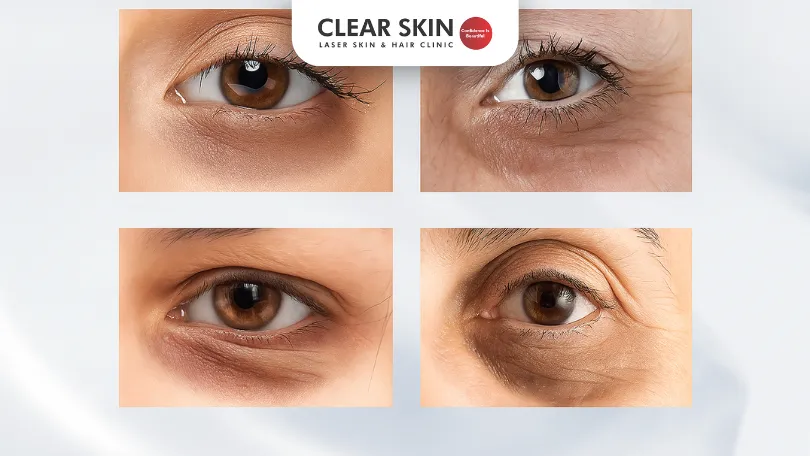The Different Types of Dark Circles and How to Treat Them?

Written by Clear Skin Content Team | Medically Reviewed by Dr. Dhanraj Chavan on August 23, 2025

Dark circles aren’t all the same—knowing their type is the first step to finding the right treatment for brighter, youthful under-eyes.
Dark circles under the eyes are a common cosmetic concern that can make you look tired, stressed, or older than you are. While they are typically harmless, their persistent presence can often affect self-confidence. Understanding the different types of dark circles, their causes, and tailored treatments is the first step in effectively managing this condition.
At Clear Skin Clinic, Pune, our dermatological experts offer advanced solutions to tackle any dark circle type. With professional care and effective treatments, you can achieve brighter, healthier-looking under-eye skin.
Table Of Content
- What Are Dark Circles and Their Causes?
- Types of Dark Circles
- General Home Care and Lifestyle Modifications
- Consult a Dermatologist for Personalised Care
- FAQs
- Conclusion
What Are Dark Circles and Their Causes?
Common Causes of Dark Circles include:
- Genetics: Family history of pigmentation or vascular prominence underneath the lower eyelids.
- Thin Skin: The skin under the eyes is delicate and becomes thinner with age, exposing blood vessels and contributing to a shadowed appearance.
- Lifestyle Habits: Poor sleep, prolonged screen time, stress, and dietary deficiencies often exacerbate dark circles.
- Medical Issues: Allergies, chronic sinus conditions, or dehydration can lead to puffiness and discoloration in the under-eye region.
Dark circles are not all the same, which is why identifying the specific type is crucial for choosing the right treatment.
Types of Dark Circles
1. Pigmented Dark Circles
What Are They?
Pigmented dark circles are caused by the overproduction of melanin, making the skin around the eyes look darker. This is especially common in individuals with darker skin tones due to higher melanin levels.
How to Identify Them:
- The skin under the eyes appears brown or black.
- The pigmentation does not worsen with changes in lighting or eye movement.
Treatment Options:
- Medical Treatments:
- Chemical Peels: Formulations with glycolic acid or retinol to exfoliate and lighten pigmentation.
- Lasers: Non-invasive treatments like Q-switched lasers to target and reduce melanin clusters.
- Home Care and Prevention:
- Daily sunscreen (SPF 30+) to prevent UV-induced pigmentation.
- Topical creams containing ingredients like Vitamin C, kojic acid, and niacinamide.
2. Vascular Dark Circles
What Are They?
Vascular dark circles are caused by blood vessels visible through thin skin. They can also develop due to poor blood circulation or retention of blood beneath the eyes.
How to Identify Them:
- The under-eye area appears bluish or purple.
- The discoloration worsens when observed under certain lighting or after fatigue.
Treatment Options:
- Medical Treatments:
- Laser Therapy: Pulsed dye or diode lasers improve circulation and reduce visible blood vessels.
- Topical Treatments: Prescription creams with caffeine or Vitamin K to constrict blood vessels.
- Home Care and Prevention:
- Regularly apply cold compresses to reduce vascular dilation.
- Elevate your head during sleep to improve fluid drainage.
3. Structural (Hollow) Dark Circles
What Are They?
Hollow dark circles occur due to a loss of fat or collagen around the eyes, causing a sunken appearance that casts shadows. This is most commonly seen with ageing.
How to Identify Them:
- Dark shadows are prominent, even in good lighting.
- The skin feels thinner and lacks elasticity.
Treatment Options:
- Medical Treatments:
- Hyaluronic Acid Fillers: Dermal fillers restore lost volume and reduce the shadowing effect.
- Microneedling with PRP (Platelet-Rich Plasma): Boosts collagen production to thicken and plump the skin.
- Home Care and Prevention:
- Moisturise with hyaluronic acid-based creams to maintain hydration.
- Include antioxidant-rich foods in your diet to boost collagen levels.
4. Mixed Type Dark Circles
What Are They?
Mixed-type dark circles are a combination of two or more of the above types. For example, pigmented and vascular dark circles appearing together are a common combination.
How to Identify Them:
- Multiple contributing factors, such as both pigmentation and visible blood vessels, are present.
- Usually evident without any clear dominance of one underlying cause.
Treatment Options:
- Medical Treatments:
- Combination therapies involving lasers, peels, and fillers tailored to address multiple issues.
- Home Care and Prevention:
- Follow a comprehensive skincare regimen combining sun protection, hydration, and targeted topical creams.
General Home Care and Lifestyle Modifications
While professional treatments are often necessary for lasting results, a few lifestyle changes and home care practices can significantly improve under-eye skin health.
Key Tips:
- Sleep Well: Aim for 7–8 hours of quality sleep daily.
- Hydrate Adequately: Drink 2–3 litres of water to prevent dryness and puffiness.
- UV Protection: Always apply sunscreen and wear UV-protective sunglasses.
- Diet: Incorporate iron-rich foods and antioxidants like leafy greens, berries, and nuts into your meals.
- Moisturise Daily: Use under-eye creams suitable for your skin type, particularly those with peptides or caffeine.
Consult a Dermatologist for Personalised Care
Addressing dark circles requires more than generic solutions. Seeking advice from an experienced dermatologist is the best way to identify and treat the underlying cause of your dark circles safely and effectively. At Skin Specialist Clinic, Pune, our specialists conduct detailed diagnostics and tailor treatments to your unique needs, ensuring optimal results.
FAQs
1. Can dark circles be treated permanently?
Yes, professional treatments like lasers, fillers, and PRP can offer long-lasting results. However, maintenance and preventive care are essential for sustained improvement.
2. Are home remedies effective for dark circles?
Home remedies like cold compresses and gentle massages may provide temporary relief but are unlikely to address underlying causes such as pigmentation or ageing.
3. Do treatments differ based on skin type?
Yes, treatment plans are personalised to accommodate individual skin types and the underlying causes of dark circles.
4. How long does it take to see results?
Results depend on the treatment type. For example, fillers provide immediate effects, while laser therapies usually require multiple sessions spaced over weeks or months.
Do You Know?
Roughly 250 Patients Are Treated
Everyday By These Dermatologists
(You are one click away from flawless skin)
Meet Our Dermatologist!
Conclusion
Understanding the type of dark circle you have is critical for effective treatment. Whether you’re dealing with pigmentation, vascular issues, or structural changes, professional care from skilled dermatologists ensures safe and lasting results.
For advanced, tailored solutions, visit Skin Specialist, Pune, today and take the first step towards rejuvenated, healthy under-eye skin!
Further Reading
How Long Do Acne Treatments Take to Show Results in Pune?
Wondering how long acne treatment takes to show results in Pune? Explore detailed treatment plans customized by expert dermatologists for faster, clearer skin.
Can You Do Laser Hair Removal Over Tattoos?
Discover if laser hair removal is safe over tattoos. Learn how to protect your tattoo while getting rid of unwanted hair. Clear Skin offers expert advice
Does Melasma Go Away in Winter?
Understand whether melasma fades in winter, why pigmentation changes with seasons, and how to manage dark patches effectively.
Cost of Acne Scar Treatments in Pune – What Patients Should Know?
Confused between laser and chemical peel for acne scars? Discover which acne scar treatment in Pune suits your skin best at Clear Skin Clinic.
Have thoughts? Please let us know
We are committed not only to treating you, but also educating you.





